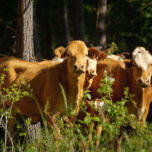November 9, 2018 — Our food is eating up the world’s tropical forests, thanks to growing global trade in agricultural commodities from tropical countries. Land for agricultural production comes at the cost of natural habitats, and habitat destruction affects the climate, water cycles and the species that live in them.
Perhaps nowhere is this more obvious than in the soybean industry. Soy is a wonderful crop. Its versatility, palatability and high protein content have made it a go-to ingredient for animal feed. Our growing appetite for meat has pushed global soy production from around 27 million metric tons (30 million tons) in 1960 to around 350 million metric tons (386 million tons) today.
Brazil, Argentina and Paraguay make up part of what is known as the Soy Republic, now producing over half of the world’s soy. China and the EU are the largest export markets for this soy, and as the U.S.-China trade war starts to bite, demand from China is only likely to accelerate.
This expansion has come at the expense of important natural habitats, first in the Amazon, but now also threatening Brazil’s Cerrado savanna and the Gran Chaco dry forest, which stretches from Argentina into Paraguay and Bolivia.
However, new developments in technology and access to data mean it doesn’t have to be this way.
A Hidden Problem
Why do we still destroy tropical forests to produce food? In part, we can blame it on humanity’s tendency to prioritize short-term profits over long-term sustainability. But one more specific answer lies in the complexity of many “forest risk” commodity supply chains — a complexity that tends to hide the impacts of production from view.
Take soy again. It is practically invisible in our food, only rarely appearing on ingredient lists. By the time it reaches our plates, most of it has already been “embedded” in meat, fish and other animal products. Palm oil, another major forest-risk crop, is hidden in a whole range of products from pastry to toothpaste (although in Europe at least it must be listed as an ingredient in foods).
Consumers generally don’t even know these ingredients are there, let alone where they were produced, so we are oblivious to the damage to rainforests and other habitats. Any potential willingness to pay for more sustainable alternatives is lost, and the market-based incentives are limited — even in markets where “ethical consumerism” is relatively high and retailers are committed to zero deforestation.
Transparency Is Key
Certification schemes can make hidden environmental costs more visible and give consumers the power to choose more sustainable options. The Roundtable on Sustainable Palm Oil (RSPO) certifies palm oil, and the similar but less-used Round Table on Responsible Soy (RTRS) certifies soy.
But RSPO- and RTRS-certified products supply only a small fraction of total global demand. Other solutions are also needed that can deliver change more quickly and at larger scales. Transparency about where commodities come from is key to this. With greater transparency, retailers can understand what is happening in their supply chains and see whether they might unwittingly be sourcing from areas where deforestation is taking place.
With more transparent supply chains, companies can identify where there are risks and where more sustainable options could be found — or created. They can then engage with suppliers to address those risks.
Technology and open data can help. Blockchain is one example; that technology can allow consumers to assess the social and environmental impacts of certain products. Satellite imagery and detailed trade and supply chain data can also help, making it possible to link many commodities, such as soy, back to at least the regions where they were produced. The organizations we work for — the Stockholm Environment Institute and Global Canopy — have developed one tool called Trase for digging into the sustainability of food-related supply chains, and there are others out there as well.
With more transparent supply chains, companies can identify where there are risks and where more sustainable options could be found — or created. They can then engage with suppliers to address those risks.
Transparency also lets companies focus on improving problematic supply chains, rather than grappling in the dark. For companies managing supply chains that stretch around the world, it makes a mammoth task more manageable.
Joined-up Thinking
Supply chain transparency can also guide governments, consumers and environmental groups to push for change. While action by one company is a step in the right direction, ultimately the goal is sectoral change. By focusing on the whole supply chain, a much more useful picture emerges of who is involved.
For example, Trase data show that only six big traders controlled 57 percent of Brazil’s soy exports in 2016. Plotting their activities against deforestation maps shows all are sourcing soy from areas at the forest frontier.
If we are to halt deforestation and protect some of the most biodiverse and vulnerable ecosystems on Earth, supply chain transparency is key.
Further down the supply chains, we see that some countries’ imports of Brazilian soy are more likely to be associated with deforestation risk than others. So while China is the biggest market for Brazilian soy, some European countries tend to import soy with a higher deforestation risk per ton, by virtue of their sourcing patterns.
Talking to the dominant trading companies — and with government authorities in producer and consumer countries — must be part of the solution.
There have been encouraging signs that some of the major players are starting to move in the right direction. To date, seven European countries have signed on to the Amsterdam Declaration on deforestation, which pledges action to reduce, and eventually eliminate, deforestation-linked supply chains. A growing number of companies support the Cerrado Manifesto, calling for an end to native vegetation loss in the vulnerable Cerrado savanna in Brazil. And there are also national-level private sector initiatives such as the Soy Buyers Coalition.
Importantly, these initiatives recognize the need to act collectively. But they need to become more effective, and they need to spread to other forest-risk commodities, including beef and cocoa, if we are to halt deforestation and protect some of the most biodiverse and vulnerable ecosystems on Earth. Across this complex picture of commodities and landscapes, supply chain transparency is key to making this happen. ![]()
Editor’s note: The views expressed here are those of the author and not necessarily of Ensia. We present them to further discussion around important topics. We encourage you to respond with a comment below, following our commenting guidelines, which can be found on this page. In addition, you might consider submitting a Voices piece of your own. See Ensia’s Contact page for submission guidelines.
Related Posts
Ensia shares solutions-focused stories free of charge through our online magazine and partner media. That means audiences around the world have ready access to stories that can — and do — help them shape a better future. If you value our work, please show your support today.
Yes, I'll support Ensia!





